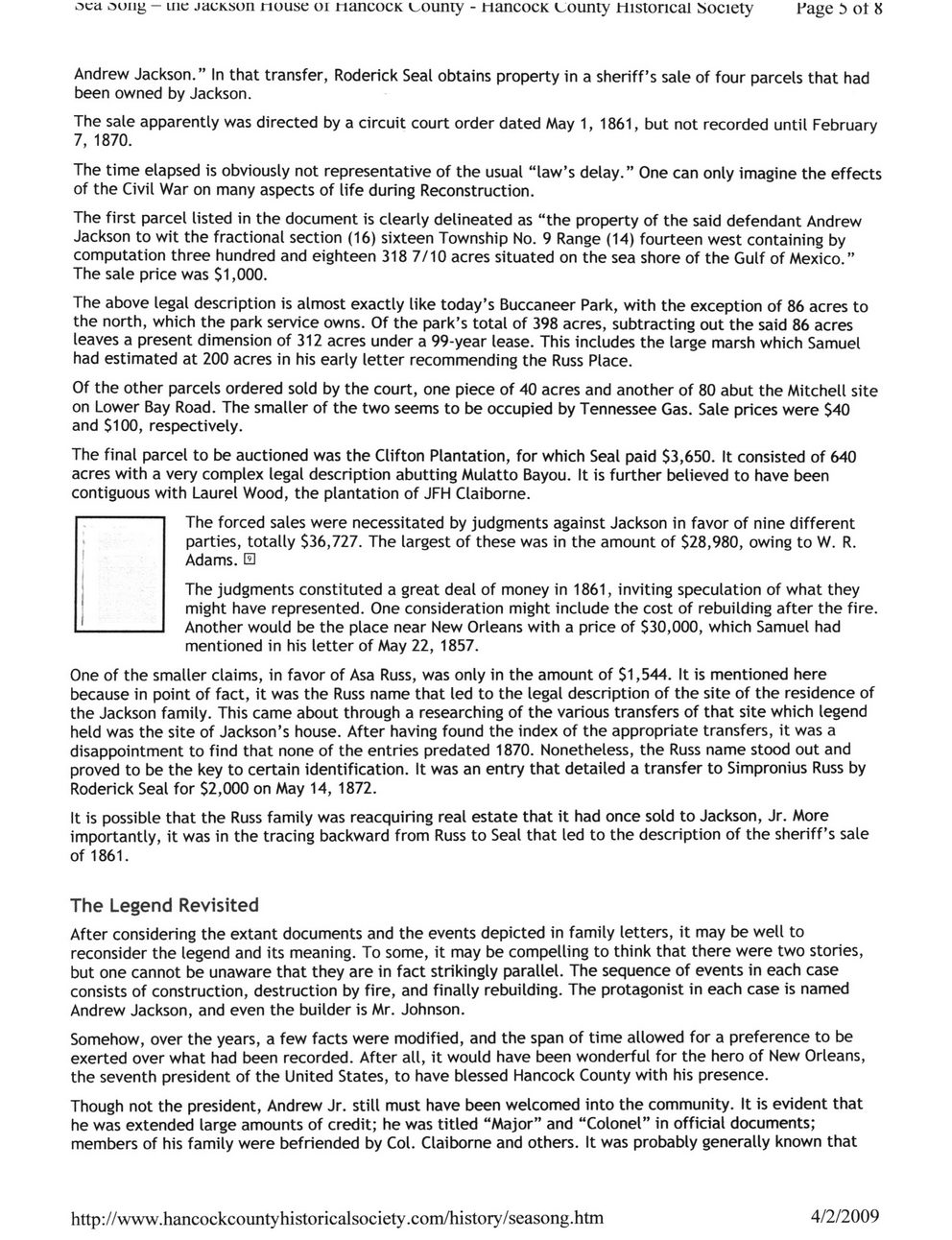This text was obtained via automated optical character recognition.
It has not been edited and may therefore contain several errors.
sea sung - me .mcKsun nouse or nancocK county - HancocK county Historical Society Page!) ot 8 Andrew Jackson.? In that transfer, Roderick Seal obtains property in a sheriff?s sale of four parcels that had been owned by Jackson. The sale apparently was directed by a circuit court order dated May 1, 1861, but not recorded until February 7, 1870. The time elapsed is obviously not representative of the usual ?law?s delay.? One can only imagine the effects of the Civil War on many aspects of life during Reconstruction. The first parcel listed in the document is clearly delineated as ?the property of the said defendant Andrew Jackson to wit the fractional section (16) sixteen Township No. 9 Range (14) fourteen west containing by computation three hundred and eighteen 318 7/10 acres situated on the sea shore of the Gulf of Mexico.? The sale price was $1,000. The above legal description is almost exactly like today?s Buccaneer Park, with the exception of 86 acres to the north, which the park service owns. Of the park?s total of 398 acres, subtracting out the said 86 acres leaves a present dimension of 312 acres under a 99-year lease. This includes the large marsh which Samuel had estimated at 200 acres in his early letter recommending the Russ Place. Of the other parcels ordered sold by the court, one piece of 40 acres and another of 80 abut the Mitchell site on Lower Bay Road. The smaller of the two seems to be occupied by Tennessee Gas. Sale prices were $40 and $100, respectively. The final parcel to be auctioned was the Clifton Plantation, for which Seal paid $3,650. It consisted of 640 acres with a very complex legal description abutting Mulatto Bayou. It is further believed to have been contiguous with Laurel Wood, the plantation of JFH Claiborne. " The forced sales were necessitated by judgments against Jackson in favor of nine different parties, totally $36,727. The largest of these was in the amount of $28,980, owing to W. R. ! Adams. 0 The judgments constituted a great deal of money in 1861, inviting speculation of what they I might have represented. One consideration might include the cost of rebuilding after the fire. J___________ Another would be the place near New Orleans with a price of $30,000, which Samuel had mentioned in his letter of May 22, 1857. One of the smaller claims, in favor of Asa Russ, was only in the amount of $1,544. It is mentioned here because in point of fact, it was the Russ name that led to the legal description of the site of the residence of the Jackson family. This came about through a researching of the various transfers of that site which legend held was the site of Jackson?s house. After having found the index of the appropriate transfers, it was a disappointment to find that none of the entries predated 1870. Nonetheless, the Russ name stood out and proved to be the key to certain identification. It was an entry that detailed a transfer to Simpronius Russ by Roderick Seal for $2,000 on May 14, 1872. It is possible that the Russ family was reacquiring real estate that it had once sold to Jackson, Jr. More importantly, it was in the tracing backward from Russ to Seal that led to the description of the sheriff?s sale of 1861. The Legend Revisited After considering the extant documents and the events depicted in family letters, it may be well to reconsider the legend and its meaning. To some, it may be compelling to think that there were two stories, but one cannot be unaware that they are in fact strikingly parallel. The sequence of events in each case consists of construction, destruction by fire, and finally rebuilding. The protagonist in each case is named Andrew Jackson, and even the builder is Mr. Johnson. Somehow, over the years, a few facts were modified, and the span of time allowed for a preference to be exerted over what had been recorded. After all, it would have been wonderful for the hero of New Orleans, the seventh president of the United States, to have blessed Hancock County with his presence. Though not the president, Andrew Jr. still must have been welcomed into the community. It is evident that he was extended large amounts of credit; he was titled ?Major? and ?Colonel? in official documents; members of his family were befriended by Col. Claiborne and others. It was probably generally known that http://www.hancockcountyhistoricalsociety.com/history/seasong.htm 4/2/2009

Bookter Alexander-019